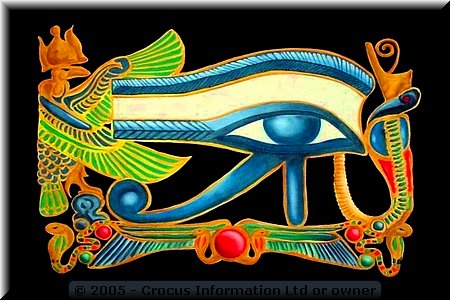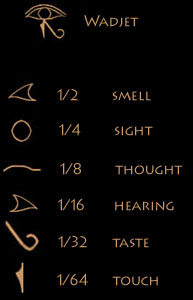Mystery of Eye of Horus
 | The Eye of Horus (Wedjat) (previously Wadjet and the Eye of the Moon; and afterwards as The Eye of Ra) or ("Udjat") is an ancient Egyptian symbol of protection and royal power from deities, in this case from Horus or Ra. The symbol is seen on images of Horus' mother, Hathor, and on other deities associated with her.
In the Egyptian language, the word for this symbol was "Wedjat". It was the eye of one of the earliest of Egyptian deities, Wadjet, who later became associated with Bast, Mut, and Hathor as well. Wedjat was a solar deity and this symbol began as her eye, an all seeing eye. In early artwork, Hathor is also depicted with this eye. Funerary amulets were often made in the shape of the Eye of Horus. |
The Wedjat or Eye of Horus is "the central element" of seven "gold, faience, carnelian and lapis lazuli" bracelets found on the mummy of Shoshenq II. The Wedjat "was intended to protect the king [here] in the afterlife" and to ward off evil. Ancient Egyptian and Near Eastern sailors would frequently paint the symbol on the bow of their vessel to ensure safe sea travel.
Horus
Horus was an ancient Egyptian sky god in the form of a falcon. The right eye represents a Peregrine Falcon's eye and the markings around it, that includes the "teardrop" marking sometimes found below the eye. As the wadjet (also udjat or utchat), it also represented the sun, and was associated with Horus' mother, Isis, and with Wadjet another goddess, as well as the sun deity Ra (Re). The mirror image, or left eye, sometimes represented the moon and the god Tehuti (Thoth).
Eye of Horus, a hieroglyph
Seven different hieroglyphs are used to represent the "eye"-(human body parts). One is the common usage of the verb: to do, make, or perform. The other frequently used hieroglyph is the Wedjat, a sacred protective symbol, called the Eye of Horus after his cult rose to prominence as the son of Hathor.
 |
In the Ancient Egyptian measurement system, the Eye Of Horus defined an Old Kingdom rounded off number one (1) = 1/2 + 1/4 + 1/8 + 1/16 + 1/32 + 1/64, by throwing away 1/64. The Eye of Horus statements created 6-term rounded off numbers. The Old Kingdom definition had dropped a 7th term, a remainder 1/64, that was needed to report exact series.
During the Middle Kingdom that included the eleventh through fourteenth dynasties, exact series definitions and applications were written by creating 7-terms, or more, written as Egyptian fraction series, often scaled to 1/320 hekat.
For example, the Egyptian Mathematical Leather Roll, the RMP 2/n table and the Akhmim Wooden Tablet wrote quotients and Egyptian fraction remainders that solved the problem. The metaphorical side of this information linked the Old Kingdom six fractions, 1/2, 1/4, 1/8, 1/16, 1/32, and 1/64 to separate parts of the eye, as noted by: |
* 1/2 was represented by smell, symbolized by the right side of the eye in a form of the nose. The pyramid text says: "Behold [the fire] rises in Abydos and it comes; I cause it to come, the Eye of Horus. It is set in order upon thy brow, O Osiris Khenti-Amenti; it is set in the shrine and rises on thy brow."
* 1/4 was represented by sight or the sensation of light, symbolized by the pupil. The pyramid text says: "Perfect is the Eye of Horus. I have delivered the Eye of Horus, the shining one, the ornament of the Eye of Ra, the Father of the Gods."
* 1/8 was represented by thought, symbolized by the eyebrow. The pyramid text says: "...the Eye of Horus hath made me holy...I will hide myself among you, O ye stars which are imperishable. My brow is the brow of Ra."
* 1/16 was represented by hearing, symbolized by the left side of the eye in the form of an arrow pointing towards the ear. The pyramid text says: "That which has been shut fast/dead hath been opened by the command of the Eye of Horus, which hath delivered me. Established are the beauties on the forehead of Ra."
* 1/32 was represented by taste, by the sprouting of wheat or grain from the planted stalk, symbolized by a curved tail. The pyramid text says: "Come, the Eye of Horus hath delivered for me my soul, my ornaments are established on the brow of Ra. Light is on the faces of those who are in the members of Osiris."
* 1/64 was represented by touch, symbolized by a leg touching the ground, or what can also be thought of as a strong plant growing into the surface of the earth. The pyramid text says: "I shall see the Gods and the Eye of Horus burning with fire before my eyes!"
In the Middle Kingdom the 1/64 symbol denoted 'rest' and 'healing' as connected to the hekat, with the word dja being attached.
The 'Eye of Horus' fractions were further discussed in the Egyptian Mathematical Leather Roll following elementary definitions that built the Egyptian fraction system. Weights and measure subunits of a hekat were also connected to Eye of Horus numbers in the quotient, and as an exact remainder, the remainder including an Egyptian fraction and a ro unit, correcting the Eye of Horus 1/64 round off error. The ro unit, 1/320 of a hekat was cited in the Rhind Mathematical Papyrus and as applied in the medical texts, like the Ebers Papyrus. A precise mathematical derivation of ro is found in the Akhmim Wooden Tablet.

Discuss and comment on article |
Article Link
|
More ghost stories on Unexplained Mysteries
|



![]()